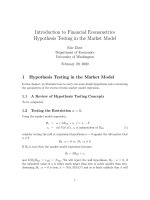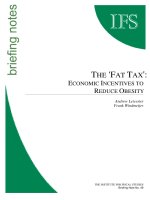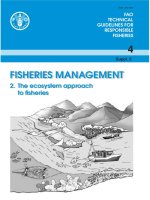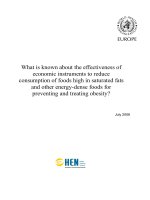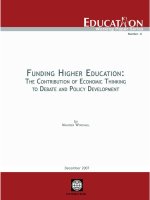Economic Solutions to Environmental Problems: The Market Approach
Bạn đang xem bản rút gọn của tài liệu. Xem và tải ngay bản đầy đủ của tài liệu tại đây (294.21 KB, 26 trang )
Chapter 5
Economic Solutions to
Environmental Problems: The
Market Approach
© 2004 Thomson Learning/South-Western
Descriptive Overview
Market approach – an incentive-based policy
that encourages conservative practices or
pollution reduction strategies
Difference between market approach and commandand-control approach is how each approach attempts
to achieve its objectives
2
Descriptive Overview
Identifying Types of Market Instruments
Pollution charge
Subsidies
Deposit/refund systems
Pollution permit trading systems
3
Pollution Charges
Pollution charge – a fee that varies with the
amount of pollutants released
“Polluter-pays principle”
Product charge – a fee added to the price of a
pollution-generating product based on its quantity or
some attribute responsible for pollution
4
Pollution Charges
Modeling a Product Charge as a Per Unit Tax
Policy motivation of a product charge is to induce
firms to internalize the externality by taking account of
the MEC in their production decisions
Pigouvian tax – a unit charge on a good whose
production generates a negative externality such that
the charge equals the MEC at Q
Assessing the Model
Difficult to identify the dollar value of MEC at Q
Model implicitly allows only for an output reduction to
abate pollution
E
E
5
Pollution Charges
Figure 5.1 Implementation of a Pigouvian Tax to Achieve
Efficiency
6
Pollution Charges
Modeling an Emission Charge: Single-Polluter
Case
Emission or effluent charge – a fee imposed directly
on the actual discharge of pollution
Assessing the Model
Emission charge stimulates the natural economic
incentives of the polluter
7
Pollution Charges
Figure 5.2 Modeling an Emission Charge for a Single Firm
8
Pollution Charges
Figure 5.3 Effect of Technology Improvement on a Firm’s
Least-Cost Decision Making
9
Pollution Charges
Modeling an Emission Charge: Multi-Polluter Case
Assessing the Model
Emission charge exploits each polluter’s natural
incentive to pursue a least-cost strategy
Low-cost abaters do most of the cleaning up and highcost abaters pay more in taxes to cover the greater
damages they cost
Potential increase in monitoring costs
Part of tax burden is shared with consumers in form of
higher prices
10
Pollution Charges
Figure 5.4 Effect of an Emission Charge in a Two-Polluter
Model
11
Pollution Charges
Pollution Charges In Practice
Internationally, pollution charge is most commonly used
market-based instrument
Several countries use effluent charges to control the
noise pollution generated by aircraft
Real-world application of the product charge is one
levied on lubricant oils by Finland, Hungary, and Italy
12
Environmental Subsidies
Two major types of subsidies:
Abatement equipment subsidies
Pollution reduction subsidies
13
Environmental Subsidies
Modeling an Abatement Equipment Subsidy
Abatement equipment subsidy – a payment aimed at
lowering the cost of abatement technology
Attempts to internalize the positive externality
associated with the consumption of abatement
activities
Pigouvian subsidy – a per unit payment on a good
whose consumption generates a positive externality
such that the payment equals the MEB at Q
Assessing the model
E
Difficulty measuring the MEB
May bias polluters’ decisions about how best to abate
14
Environmental Subsidies
Modeling a Per Unit Subsidy on Pollution
Reduction
Per unit subsidy on pollution reduction – a payment
for every unit of pollution removed below some predetermined level
Assessing the Model
Might be less disruptive than an equipment subsidy
Can have perverse effect of elevating pollution levels
in the aggregate
15
Environmental Subsidies
Environmental Subsidies in Practice
Internationally, many countries offer environmental
subsidies in the form of grants or low-interest loans
In the United States, the most common use is federal
funding for publicly owned treatment works
16
Deposit/Refund Systems
Deposit/refund system – a market instrument
that imposes an up-front charge to pay for
potential damages and refunds it for returning
a product for proper disposal or recycling
Combines the incentive characteristic of a pollution
charge with a built-in mechanism for controlling
monitoring costs
17
Deposit/Refund Systems
Economics of Deposit/refund Systems
Intended to force the potential polluter to account for
both the marginal private cost (MPC) and the marginal
external cost (MEC) of improper waste disposal
Targets the potential polluter instead of penalizing the
actual polluter
18
Deposit/Refund Systems
Modeling a Deposit/Refund System
Deposit serves the same function as a pollution
charge with the critical difference that the refund helps
to deter improper waste disposal
Assessing the Model
Encourages environmentally responsible behavior
without adding to monitoring and compliance costs
Can be used to encourage more efficient use of raw
materials
19
Deposit/Refund Systems
Figure 5.5 A Pigouvian Subsidy in the Market for Scrubbers
20
Deposit/Refund Systems
Deposit/Refund Systems in Practice
Beverage container disposal
Disposal of used tire, car hulks, and lead-acid
batteries
21
Deposit/Refund Systems
Figure 5.6 Modeling a Deposit/Refund System in the Market for
Waste Disposal
22
Pollution Permit Trading Systems
Pollution permit trading system – a market
instrument that establishes a market for
rights to pollute by issuing tradeable
pollution credits or allowances
Pollution credits – tradeable permits issued for
emitting below an established standard
Pollution allowances – tradeable permits that
indicate the maximum level of pollution that may be
released
23
Pollution Permit Trading Systems
Structure of a Pollution Trading Systems
Two components:
The issuance of some fixed number of permits in a
region
A provision for trading these permits among
polluting sources within that region
Bargaining gives rise to a market for pollution rights
24
Pollution Permit Trading Systems
Modeling a Pollution Permit System for
Multiple Polluters
Incentive to trade as long as two firms face different
MAC levels
Trading will continue until the incentive to do so no
longer exists, at which point, the cost-effective
solution is obtained
Assessing the Model
Trading establishes the price of a right to pollute
without intervention
No tax revenues are generated
Trading system is more flexible
25

